
Sustainable Development Goals (497)
The Sustainable Development Goals are a universal call to action to end poverty, protect the planet and improve the lives and prospects of everyone, everywhere. The seventeen Sustaiable Development Goals (SDG) were adopted by all UN Member States in 2015, as part of the 2030 Agenda for Sustainable Development which set out a 15-year plan to achieve the Goals.
Children categories

2 Zero Hunger (13)
End hunger, achieve food security and improved nutrition and promote sustainable agriculture

3 Good Health and Well-Being (65)
Ensure healthy lives and promote well-being for all at all ages

4 Quality Education (45)
Ensure inclusive and equitable quality education and promote lifelong learning opportunities for all

6 Clean Water and Sanitation (34)
Ensure availability and sustainable management of water and sanitation for all

7 Affordable and Clean Energy (35)
Ensure access to affordable, reliable, sustainable and modern energy for all

8 Decent Work and Economic Growth (10)
Promote sustained, inclusive and sustainable economic growth, full and productive employment and decent work for all

9 Industry, Innovation and Infrastructure (30)
Build resilient infrastructure, promote inclusive and sustainable industrialization and foster innovation

11 Sustainable Cities and Communities (162)
Make cities and human settlements inclusive, safe, resilient and sustainable

12 Responsible Consumption and Production (58)
Ensure sustainable consumption and production patterns

14 Life Below Water (83)
Conserve and sustainably use the oceans, seas and marine resources for sustainable development

15 Life on Land (152)
Protect, restore and promote sustainable use of terrestrial ecosystems, sustainably manage forests, combat desertification, and halt and reverse land degradation and halt biodiversity loss

16 Peace, Justice and Strong Institutions (31)
Promote peaceful and inclusive societies for sustainable development, provide access to justice for all and build effective, accountable and inclusive institutions at all levels

17 Partnerships for the Goals (20)
Strengthen the means of implementation and revitalize the global partnership for sustainable development
Tennessee Lookout: TWRA delays clearcut in Cumberlands as tourism official files suit
Written by Anita Wadhwani Marvin Bullock, president of the Sparta-White County Chamber of Commerce, opposes deforestation efforts in the Bridgestone-Firestone Centennial Wilderness Area to create quail habitat. John Partipillo/Courtesy of Tennessee Lookout
Marvin Bullock, president of the Sparta-White County Chamber of Commerce, opposes deforestation efforts in the Bridgestone-Firestone Centennial Wilderness Area to create quail habitat. John Partipillo/Courtesy of Tennessee Lookout
Oak Ridge Rep. John Ragan joins bipartisan pushback against state plans to raze forest for quail habitat
This story was originally published by Tennessee Lookout.
SPARTA — For decades, the Tennessee Wildlife Resources Agency has kept the profits from the sale of timber and other natural resources on publicly owned lands, folding the payments from logging companies into the agency’s annual operating budget.
A bipartisan bill introduced in the Tennessee Legislature this week seeks to bring that practice to an end. The measure, introduced by Rep. John Ragan, R-Oak Ridge, and Sen. Heidi Campbell, D-Nashville, would require TWRA officials to transfer all proceeds from the sale of the state’s natural resources into Tennessee’s general fund — the process typically followed by other Tennessee agencies that generate income.
- twra clearcut
- twra hardwood forest cutting
- twra timber cut
- tennessee lookout
- sparta, tennessee
- centennial
- tennessee wilderness area
- bridgeton centennial wilderness area
- cumberland mountains clearcut
- lawsuit against clearcut
- tennessee tourism
- rep john ragan
- oak ridge representative
- tennessee quail habitat
- marvin bullock, president of the spartawhite county chamber of commerce
Knoxville Area Transit navigates length, depth and breadth
Written by Cittlali Onate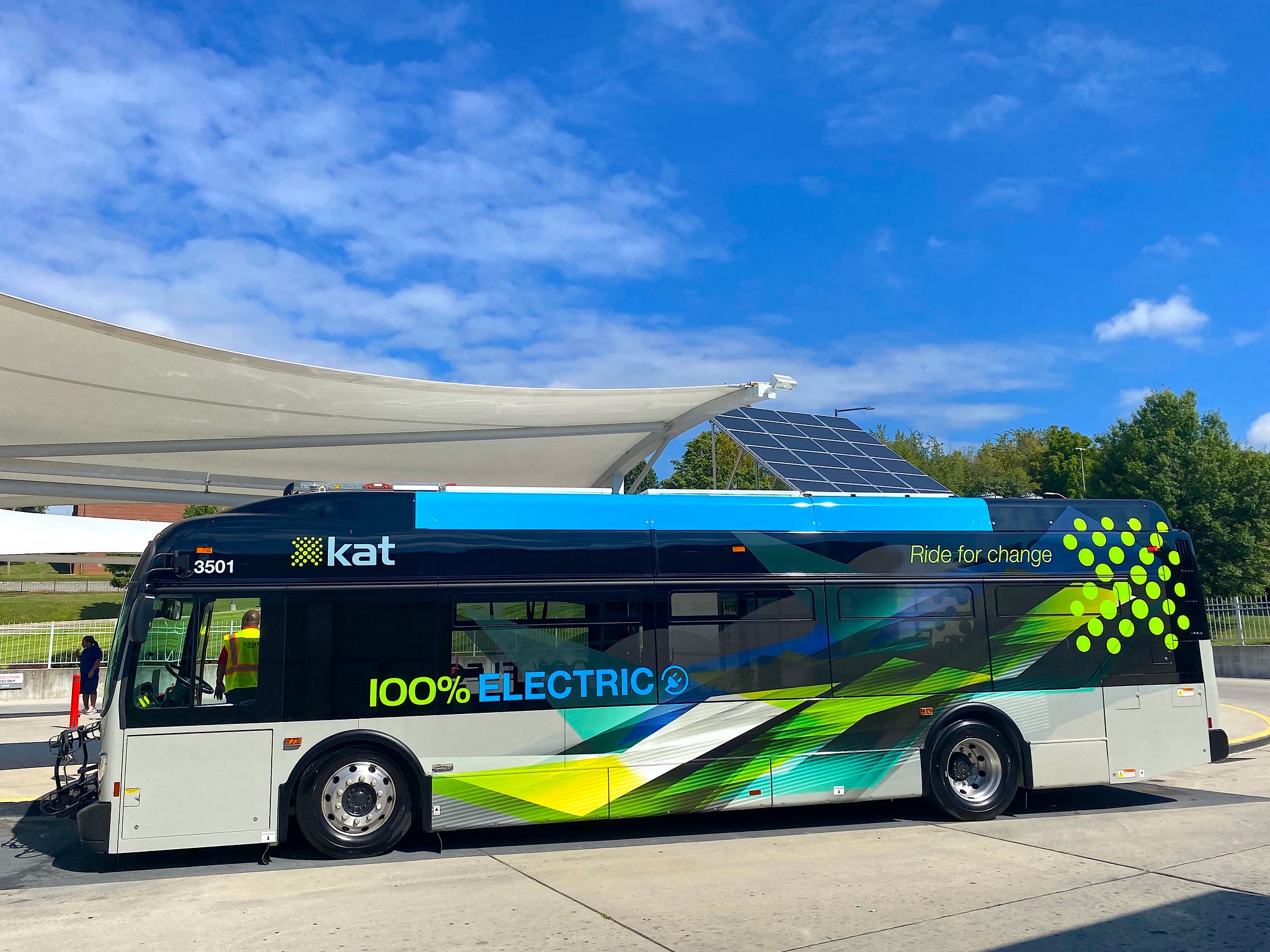 With their zero-emission drive, these quiet buses operate with 100% electric propulsion. Each electric bus helps prevent nearly 300,000 pounds of greenhouse gas emissions in our community annually. That’s like planting 2,283 trees.
With their zero-emission drive, these quiet buses operate with 100% electric propulsion. Each electric bus helps prevent nearly 300,000 pounds of greenhouse gas emissions in our community annually. That’s like planting 2,283 trees. Knoxville Area Transit
Shut up and get on the bus
KNOXVILLE — Everyone needs to be everywhere at once: School, work, the grocery story, the mall and back home.
Locked into a society run by time, we tend to prefer methods of transportation that make for the quickest journey from place to place.
The modern car, usually powered by gasoline, provides individuals with quick transportation, which saves time. Private transportation embodies convenience.
- knoxville area transit
- public transportation in knoxville
- ut environmental writing class
- kat
- why don't people use public transit
- should i take the bus
- environmental damage from vehicle
- greenhouse gas emission
- belinda woodiel brill
- environmental advantages to taking the bus
- why should i take bus in knoxville
- co2
- carbon dioxide
- electric bus
Foothills Land Conservancy saved some green in 2021
Written by Foothills Land Conservancy
Maryville-based FLC is finalizing this year’s remaining land preservation projects
131 acres in Jefferson County, TN, now preserved!

Left: Outstanding views atop this recently preserved property with cosmos blooms in foreground.
Middle: Spring-fed pond on the property.
Right: Mature forest on the west side of the property. Touch here for additional images
To date in 2021, FLC has worked with landowners to assist in the conservation of over 1,300 acres. It anticipates a few thousand more acres protected by year's end.
Highlights from the past year
Glenn and Katie Savage are two of FLC’s newest friends and partners in land conservation.
They recently placed a conservation easement on their 131-acre property, affectionately named Dancing Winds Wildlife Sanctuary and Arboretum, which is “dedicated to the preservation and protection of God’s glorious creations — plants and animals.”
Glenn has cultivated over 400 different types of trees which are planted across the property and lovingly tends his home garden full of a variety of beautiful and unique flowers.
The Savages have several fields planted in corn/grain sorghum as well as a variety of oaks and other mast-producing trees to supplement the diet of the countless white-tailed deer and turkeys that call their property home.
Glen and Katie are also avid birdwatchers and provide many types of feeders for their winged backyard visitors. The Savages say that protecting their beloved property and knowing that it will forever remain a safe haven for wildlife has given them peace of mind, and Glenn hopes in the future to convince some of his neighbors to partner with FLC to protect their land, too.
Tap here for additional images

Part IV: Clear-cut controversy. Thoughts and prayers
Written by Thomas Fraser Library of Congress
Library of Congress
Citizens and scientists weigh in on controversial TWRA logging plan
For months, Tennessee Lookout has bird-dogged a Tennessee Wildlife Resources Agency proposal to clear at least 1,000 acres of hardwood forest in the Bridgestone Centennial Wildlife Reserve in White County to create habitat for dwindling bobwhite quail.
Hellbender Press has published most of the stories, with much appreciation to Tennessee Lookout. Most recently, the online news outlet reported that legal hurdles had been cleared to allow TWRA to proceed, at least for now, with its game-bird reintroduction plans at the expense of acres of approximately 65-year-old hardwood forest.
Though it was not Hellbender’s original reporting, on our end the social media response to the articles has been thoughtful and reasoned — with, of course, occasional disagreements among commenters. With permission from the posters, I’ve compiled an edited and abridged recitation of some comments, which were too good to languish in the social media ether.
Part III: Clear-cut controversy in the Cumberlands
Written by Anita Wadhwani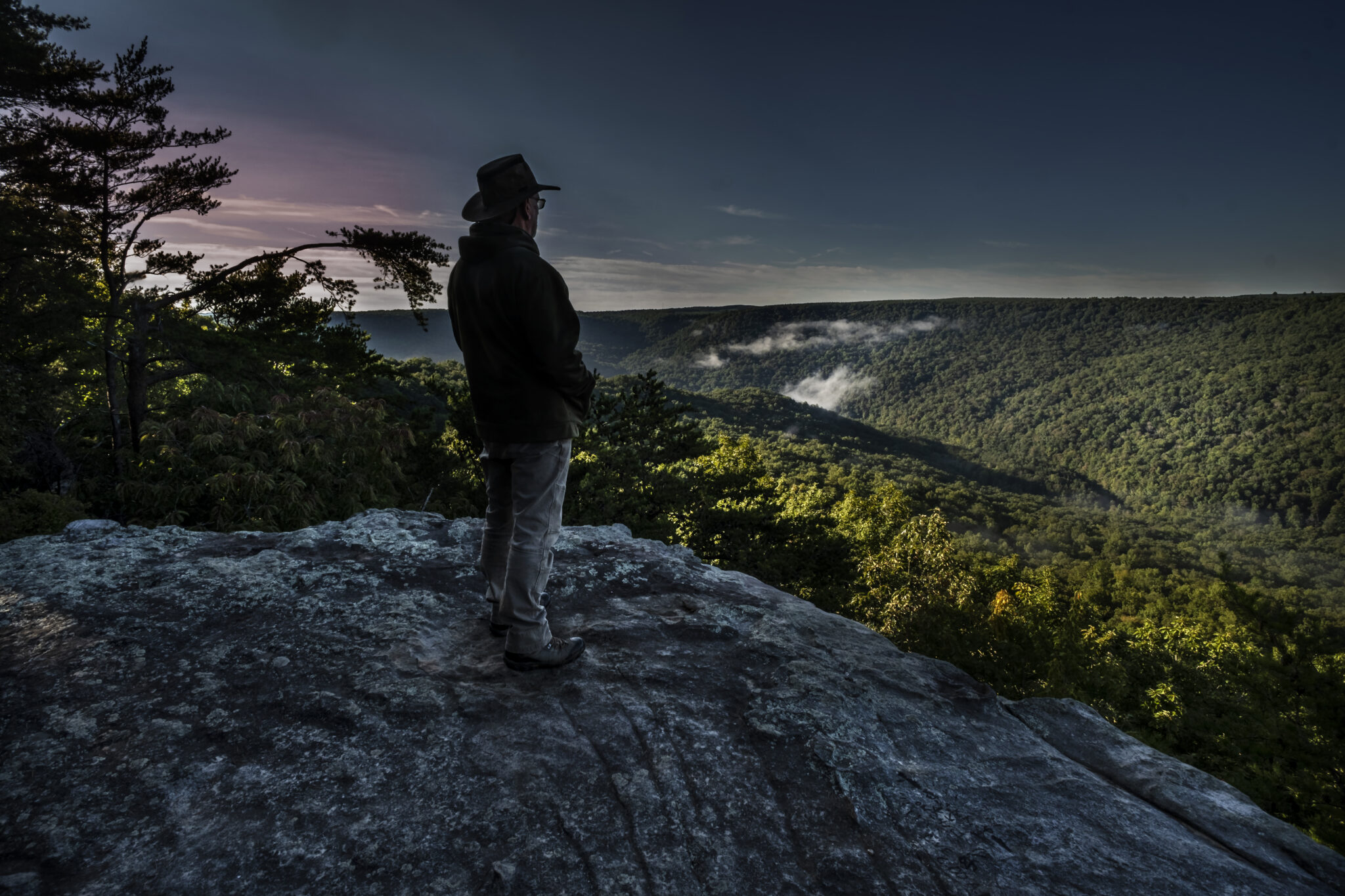
Legal opinion cuts path for TWRA forest clearing in White County’s Bridgestone wilderness area despite local opposition
This story was originally published by Tennessee Lookout.
A controversial plan by the Tennessee Wildlife Resources Agency officials to clearcut forest in a popular hunting, hiking and recreation area in order to create habitat for Northern bobwhite quail has gotten a legal go-ahead, despite opposition from residents and local leaders in White County, a bipartisan group of lawmakers and environmental groups.
The 16,000-acre Bridgestone Firestone Centennial Wilderness Area, a forested area adjacent to Fall Creek Falls State Park and Virgin Falls State Natural Area, was a late 1990’s gift to the state from the tire company that came with certain strings attached, including that state officials “preserve the property predominantly in its present condition as a wilderness area.”
The Tennessee Wildlife Federation was charged with ensuring the state honors those conditions.
On Friday, a spokeswoman for the Tennessee Wildlife Federation confirmed that outside legal counsel hired to review the state’s clearcutting plan found it “meets the requirements” of the gift.
“Speaking broadly as a conservation nonprofit, we have supported throughout our 75-year history the science-based, proactive management of lands to maintain or restore diverse habitats and diverse wildlife,” Kate Hill, a Tennessee Wildlife Federation spokeswoman, said via email. “The fact is savannas are an endangered habitat in the Southeast that were once common and provided essential habitat to many species across Tennessee.”
Neither the Tennessee Wildlife Federation nor the Tennessee Wildlife Resources Agency has communicated the outcome of the legal review to local residents, who have complained for months that they have been kept in the dark and offered no meaningful opportunity to weigh in on plans to radically alter a landscape that is both beloved and central to the local economy.
- tennessee wildlife resources agency
- clearcut in bridgestone wilderness
- hardwood clearcuts tennessee
- quail unlimited
- quail habitat restoration
- quail reintroduction in tennessee
- twra clearcut
- white county clearcut
- opposition to twra clearcut
- hardwood clearcut cumberlands
- tennessee wildlife federation clearcut
Updated 8/14: Plans for Foothills Parkway extension from Wears Valley to Gatlinburg enter newest public input phase
Written by Thomas Fraser and Rick Vaughan
Critics have called for full Environmental Impact Statement amid threat to Southern Appalachian habitats; previous draft EIS identifies many rare, notable species in project right of way
GATLINBURG — Proposed construction of an unfinished section of Foothills Parkway from Wears Valley to the Gatlinburg Spur would traverse 9.8 miles of natural beauty that is home to multiple rare species identified in a 1994 study.
The federal government last month opened the latest round of public comment on the project, which would traverse Buckeye Knob and Cove Mountain and multiple aquatic and karst environments. Concerns raised by the public over the decades range from impacts on domestic water supplies and endangered or threatened species to the fact the roadway might be a catalyst for excessive tourism infrastructure in Townsend and Wears Valley.
The proposed route also extends through dense areas of pyrite, a highly acidic sulfate mineral (also known as fool’s gold) that can poison entire watersheds when exposed if proper erosion controls aren’t followed. Contamination of streams and creeks led to the decades-long delay in full construction of the existing parkway section (known as the missing link) that extends from Walland to Wears Valley.
- foothills parkway extension
- opposition to foothills parkway extension
- smokies foothills parkway
- nepa
- endangered species foothills parkway
- fhwa federal highway administration
- ea environmental assessment
- nepa national environmental policy act
- nhpa national historic preservation act
- national parks conservation association
- pyrite
- jeff hunter
- missing link of foothills parkway
(Remember this?) Report: Sen. Joe Manchin, a holdout Democrat on climate-change legislation, is a “coal baron”

The Guardian: Manchin monkey-wrenches climate change legislation because he’s made millions off fossil fuels
West Virginia Sen. Joe Manchin, the Democratic linchpin for game-changing climate legislation proposed in a budget bill as part of the Biden administration’s plan to provide aid to families as well as give a boost to efforts to reduce global warming, has thrown a now-infamous wrench in the works.
He has vigorously opposed key parts of the climate legislation included in the 2022 budget bill. Per the Guardian, it’s simply because he and his family have made a fortune off coal extraction in the relatively impoverished state of West Virginia and elsewhere.
“Financial records detailed by reporter Alex Kotch for the Center for Media and Democracy and published in the Guardian show that Manchin makes roughly half a million dollars a year in dividends from millions of dollars of coal company stock he owns. The stock is held in Enersystems, Inc, a company Manchin started in 1988 and later gave to his son, Joseph, to run,” according to the Guardian.
“He has already effectively succeeded in stripping the bill of its most powerful climate change provision, a program that would have rapidly shut down coal and gas-fired power plants and replaced them with wind and solar power,” according to the New York Times.
The ivory-billed woodpecker is officially extinct, and it strikes a chord in Knoxville
Clinging to a maple in the bayou, Jim Tanner finally had the rare nestling in his grasp.
He fitted it with a numbered leg band and placed the bird back in its hole high off the ground.
But true to its seldom-seen self, the juvenile ivory-billed woodpecker squirmed free and fluttered to the base of a giant maple tree in a southern Louisiana swamp owned at the time by the Singer Sewing Machine Co.
The year was 1936, and Jim Tanner was in the midst of doctorate research at Cornell University funded by the Audubon Society as part of a push to prevent the pending extinctions of multiple bird species, including the California condor, roseate spoonbill, whooping crane and ivory-billed woodpecker. Eighty-five years later, the regal woodpecker would be the only one grounded for eternity.
In the heat and rain of mucky, gassy bayous, Tanner compiled data on the range, population, habitat and prevalence of ivory-billed woodpeckers. He camped for weeks at a time in the swamps of the birds’ original range.
On this day, his only goal was to band the bird but he rushed down the tree and picked up the agitated but uninjured woodpecker.
He also wanted photographs.
Tanner took advantage of the moment.
He placed the bird upon the shoulder of an accompanying and accommodating game warden for 14 shots from his Leica.
They were probably the first, and perhaps the last, photographs of a juvenile ivory-billed woodpecker photographed by Tanner in its natural habitat. He named the bird Sonny, and he was the only known member of the species to be banded with a number.
The regal, smart, athletic bird, which peaceably flew over its small slice of Earth for some 10,000 years, was declared extinct last month by the Fish and Wildlife Service. Twenty-two other species also qualified for removal from the Endangered Species List — in the worst possible way.
The ivory bill inhabited the swamps of the Deep South, far removed from Rocky Top, but old visages of the departed were found in Little Switzerland in South Knoxville. The work of Tanner, who would go on to complete a rich ecological research career at the University of Tennessee, has been memorialized by a talented East Tennessee science writer.
And the Southern Appalachian region has other long-gone kinships with species that vanished from the Earth a long time ago.
Tennessee Lookout: (Part II) Thick covey of opposition to TWRA quail management at expense of mature hardwood forest
Written by Anita Wadhwani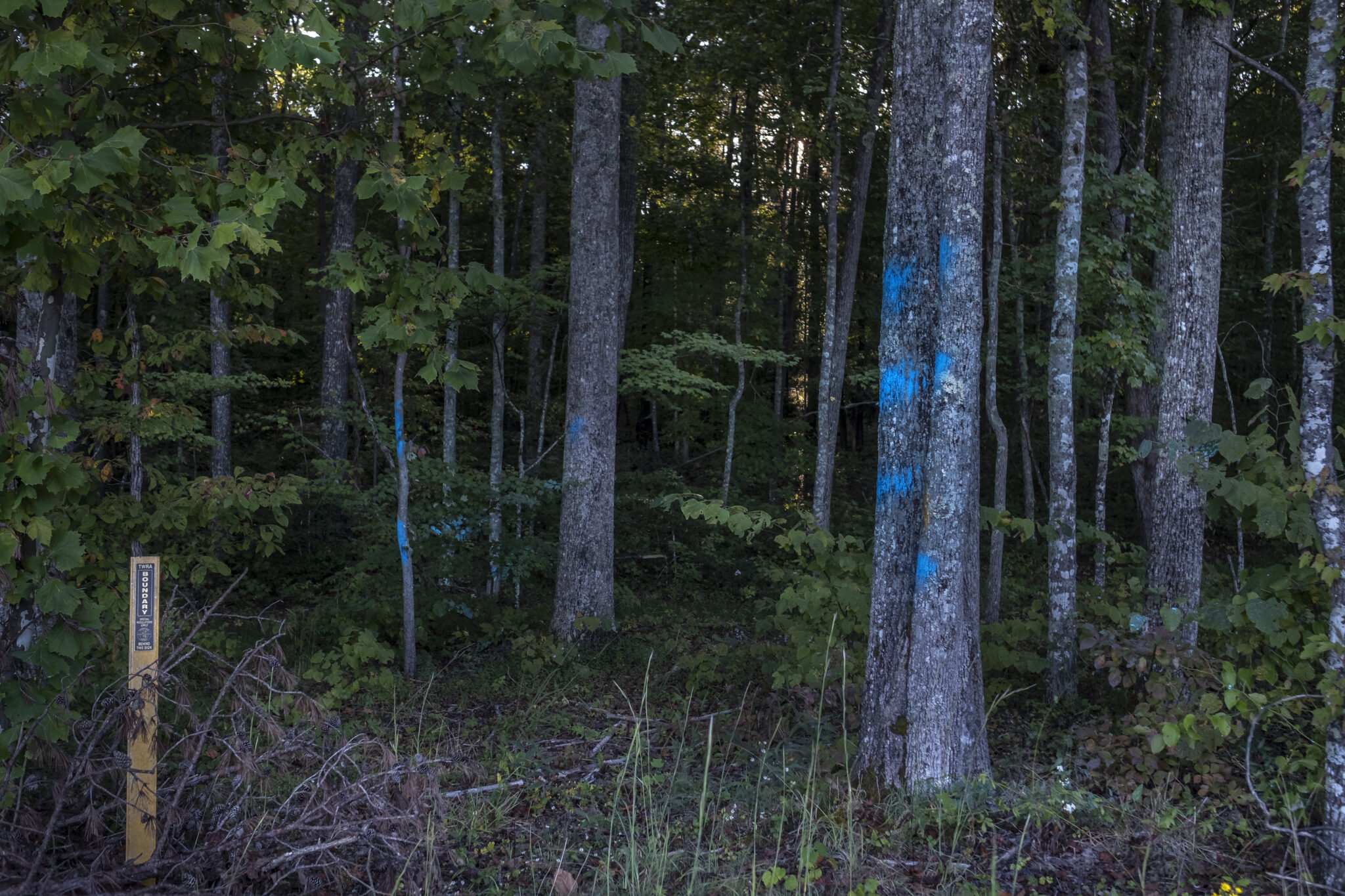 Tree trunks in the Bridgestone Firestone Centennial Wilderness Area in Sparta marked for clearcutting, despite local opposition. John Partipilo/Courtesy Tennessee Lookout
Tree trunks in the Bridgestone Firestone Centennial Wilderness Area in Sparta marked for clearcutting, despite local opposition. John Partipilo/Courtesy Tennessee Lookout
Hundreds of citizens publicly reject TWRA Middle Tennessee deforestation plans
This story was originally published by the nonprofit Tennessee Lookout and is shared (with much appreciation) with Hellbender Press via Creative Commons License.
Officials with the Tennessee Wildlife Resources Agency faced considerable pushback Monday night (Oct. 4) at a public meeting in Sparta over plans to raze old growth forest in a popular hunting and recreation area located about halfway between Nashville and Knoxville.
A standing room-only crowd of more than 200 people filled the town’s small civic center to hear directly from state officials about what had been — until now — an unpublicized internal agency plan to clear forest on public lands in the Bridgestone Firestone Centennial Wilderness Area to create grassland habitat for northern bobwhite quail, a game bird whose populations have plummeted in Tennessee.
Tennessee Lookout: Tennessee Wildlife Resources Agency reportedly plans to raze mature hardwood forest
Written by Anita Wadhwani Mike O’Neal, a longtime hunter, surveys an expanse of the Bridgestone Firestone Centennial Wilderness Area in Middle Tennessee where clearcutting of public hardwood forest is planned to create quail habitat. John Partipilo/Courtesy of Tennessee Lookout
Mike O’Neal, a longtime hunter, surveys an expanse of the Bridgestone Firestone Centennial Wilderness Area in Middle Tennessee where clearcutting of public hardwood forest is planned to create quail habitat. John Partipilo/Courtesy of Tennessee Lookout
The plan to clear forest for quail habitat is raising the ire of hunters and hikers, as well as a bipartisan group of state lawmakers
This story was originally published by the nonprofit Tennessee Lookout and is shared (with much appreciation) via Creative Commons License.
It’s a pretty bird, easily recognizable by dark stripes on rust colored feathers and a distinct two-syllable chirp that announces its name: “bob” (the high note) then “white” at a lower pitch — also known as the northern bobwhite, a species of quail.
The otherwise unassuming bird is now at the center of a fight over public lands in White County, Tennessee, pitting the Tennessee Wildlife Resources Agency against an unlikely coalition of hikers, hunters, cavers, local business leaders and state lawmakers on both sides of the political aisle.
More...
Oak Ridge National Laboratory land is an international treasure of biodiversity
Written by Abby Bower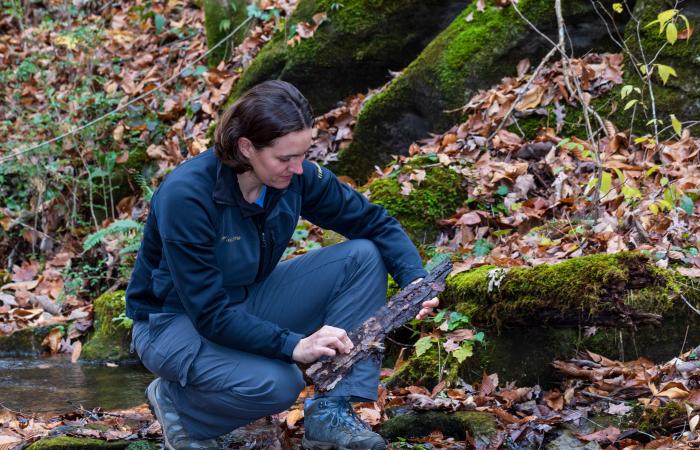 Aquatic ecologist Natalie Griffiths studies nutrients and contaminants in the Weber Branch watershed, which is in the Oak Ridge Environmental Research Park. Courtesy Carlos Jones/ORNL
Aquatic ecologist Natalie Griffiths studies nutrients and contaminants in the Weber Branch watershed, which is in the Oak Ridge Environmental Research Park. Courtesy Carlos Jones/ORNL
ORNL research lands are an international ecological benchmark and diverse wonderland of trees, plants, mammals, reptiles and amphibians
Abby Bower is a science writer for Oak Ridge National Laboratory.
The Department of Energy’s Oak Ridge National Laboratory (ORNL) is a hub for world-class science. The nearly 33,000-acre space surrounding the lab is less known, but also unique. The Oak Ridge Reservation (ORR) is a key hotspot for biodiversity in the Southeast and is home to more than 1,500 species of plants and animals.
At the intersection of Anderson and Roane counties is an important subset of the reservation — the Oak Ridge National Environmental Research Park, or NERP — a 20,000-acre ORNL research facility that has been internationally recognized by UNESCO as an official biosphere reserve unit.
“The National Environmental Research Park is a living laboratory and a major resource for conducting ecological studies,” said Evin Carter, an ORNL wildlife ecologist and director of the Southern Appalachian Man and the Biosphere Program, or SAMAB. The NERP has been a core part of SAMAB, which has focused on sustainable economic development and conserving biodiversity in Southern Appalachia since 1989.
With ORNL researchers and scientists from government agencies and academia using the NERP for diverse experiments each year, the park lives up to its status as a living laboratory.
It also lives up to its reputation as a biodiversity hotspot. As one of seven DOE-established environmental research parks reflecting North America’s major ecoregions, it represents the Eastern Deciduous Forest. The NERP comprises parts of this ecoregion that have been identified repeatedly as priorities for global biodiversity conservation, Carter said.
This designation means more than ever as climate change alters ecosystems and biodiversity declines worldwide. According to a landmark international report, on Biodiversity and Ecosystem Services, around one million plant and animal species are currently threatened with extinction.
- oak ridge national laboratory
- ornl
- ecological benchmark
- oak ridge national environmental research park
- nerp
- biosphere reserve
- southern appalachian man and the biosphere
- samab
- biodiversity
- unesco
- oak ridge reservation
- orr
- ecoregion
- culturally significant plant species initiative
- cspsi
- evin carter
- kitty mccracken
- eastern band of cherokee indians
- neon
- national ecological observatory network
- northern longeared bat
- indiana bat
- grey bat
- endangered species
- threatened species
- purple gallinule
Tragedy of the commons: Plant poaching persists in Smokies and other public lands
Written by Ben Pounds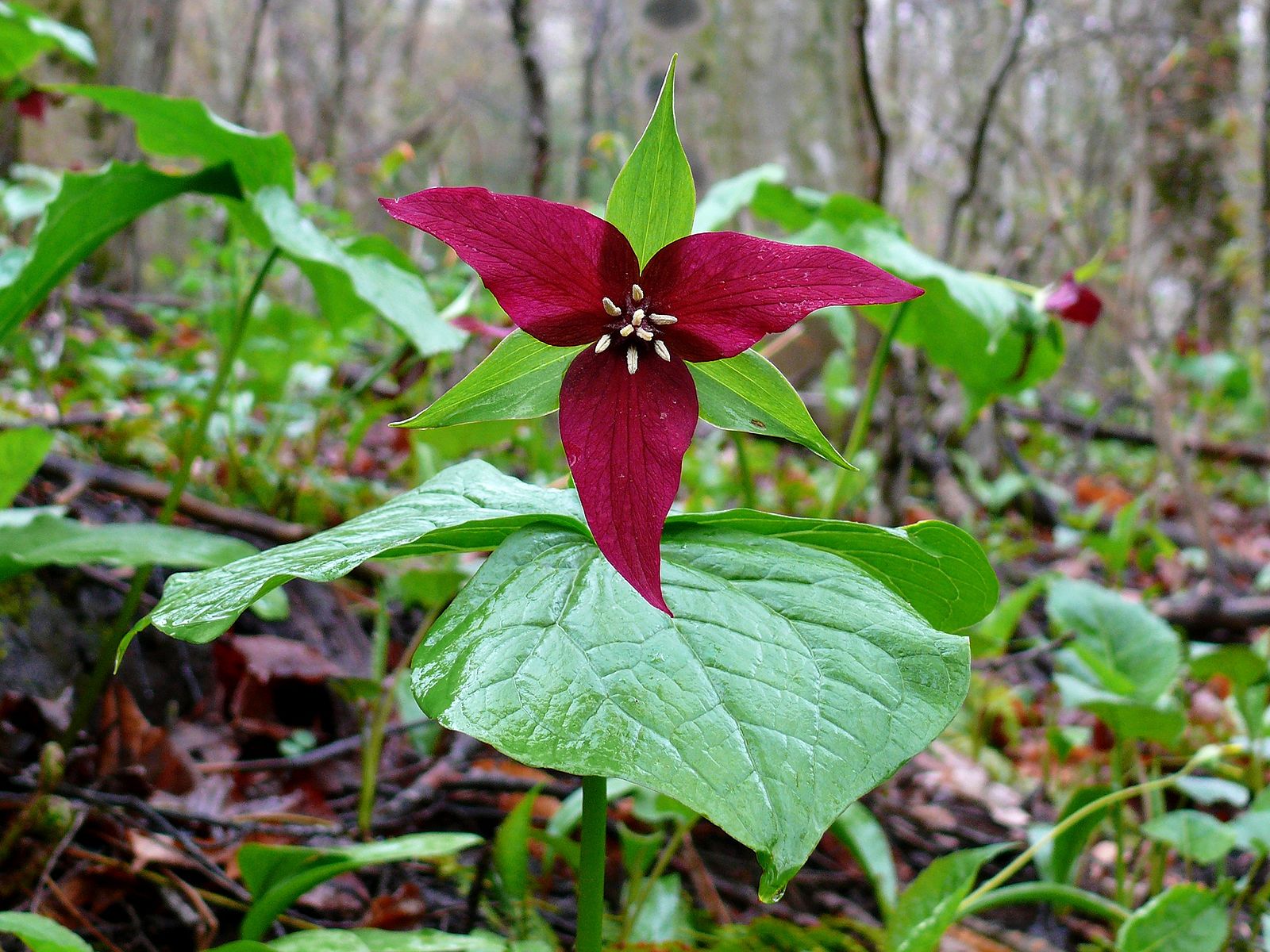 A red trillium is seen in the Southern Appalachians. It is often the target of poachers who aspire to place it in an ill-suited domestic ornamental garden. Courtesy Wiki Commons
A red trillium is seen in the Southern Appalachians. It is often the target of poachers who aspire to place it in an ill-suited domestic ornamental garden. Courtesy Wiki Commons
Forest service withholds ginseng permits to protect native Southern Appalachian plants as overall poaching persists
Paul Super has a message for people who take plants and animals from Great Smoky Mountains National Park:
It’s stealing.
“We’re trying to protect the park as a complete ecosystem and as a place that people can enjoy the wildlife and everything that lives here … but they have to do it in a sustainable way, and poaching doesn’t fit,” said Super, the park’s resource coordinator.
“Be a good citizen. Enjoy the park without damaging it.”
Super said the novel coronavirus pandemic led to the second-highest visitation to the park in 2020, just over 12 million, even with the park being closed briefly.
“This year will likely have the highest visitation ever,” he said, adding that the park is, in terms of the pandemic, a “relatively safe place for family and friends.”
Super said this higher visitation rate may lead to more poaching but it may also lead to more people who “appreciate something that a poacher would take away from them.
“Besides being illegal, that’s just selfish and rude,” Super said regarding plants and animals, and even cultural artifacts that are taken from the park.
Super is the park’s research coordinator, and is in charge of recruiting researchers to help better understand the nuances and full ramifications of stealing public natural resources. He said his researchers don’t enforce the laws, but they do alert law enforcement rangers to poaching incidents and suspicions.
- ginseng poaching
- poaching in great smoky mountains national park
- poaching in southern appalachia
- pink lady slipper
- ginseng
- smokies ginseng
- trillium
- great smoky mountains national park
- paul super
- smokies research coordinator paul super
- is removing plant from mountain illegal?
- insect poaching
- rare plant species
- ginseng trade
- butterfly poaching
- beetle poaching
- big south fork poaching
Ijams gets down to Earth with our winged friends
Written by Thomas Fraser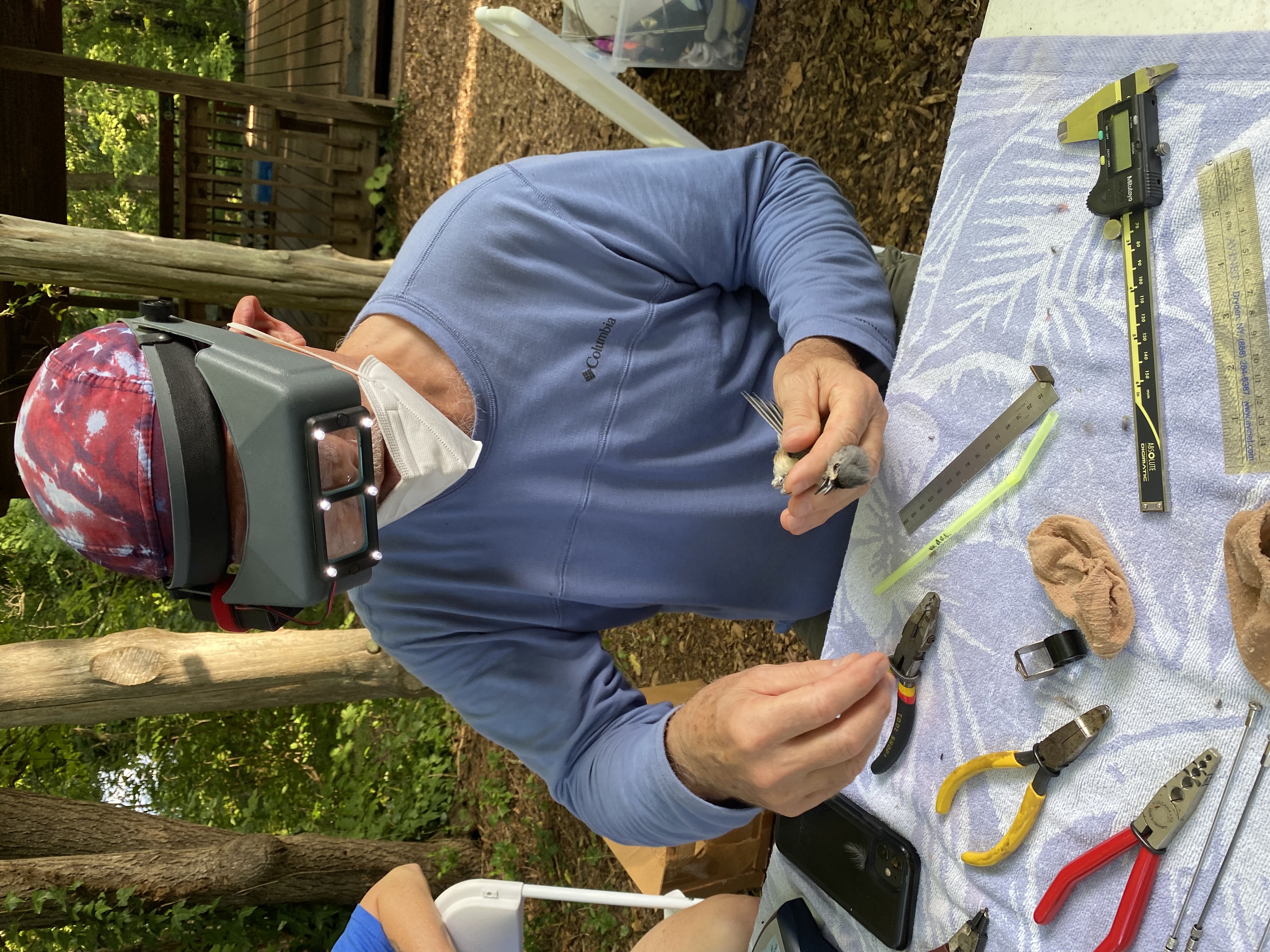
Ijams Nature Center offers a celebration of winged creatures that can bring us all to new heights
The hummingbird buzzed to freedom from a loving human hand into the early midsummer morning.
It was the latest bird to be tagged after collection from a harmless mist net as volunteer naturalists introduced the uninitiated and curious to the simple wonder of birds and the more complicated collections of data needed to ensure their wellbeing.
The hummingbird, along with at least one tufted titmouse, was just one of many feathered friends captured in the pleasantly cool air at Ijams and described in detail by naturalists and friends Saturday morning (Aug. 28) during Ijams Nature Center’s biggest annual educational showcase: the Hummingbird Festival: Celebration of Wings, presented by Ergon Terminaling Inc. and Trust Company of Tennessee.
But it was also a celebration of connections between earth and air as attendees passed from conservation displays to food and natural products and crafts stands. Animals on display ranged from an owl and groundhog to an apple-chewing opossum.
(News alert: Katy did it!) Seventeen-year cicadas were just an opening act. Now the woods are rolling with the rhythm of our annual insects.
Written by Stephen Lyn Bales A true katydid is shown here. It’s one of the main insects that provides a permanent soundtrack to your summer life in the Knoxville area. Stephen Lyn Bales/Hellbender Press
A true katydid is shown here. It’s one of the main insects that provides a permanent soundtrack to your summer life in the Knoxville area. Stephen Lyn Bales/Hellbender Press
What’s that buzz? We thought Brood X was over.
In case you haven’t noticed: It’s hot!
The “dog days of summer,” are so called because the season coincides with the period of time when the brightest star Sirius, aka the Dog Star, rises and sets with the Sun: early July through August into September.
The ancients believed that when Sirius and the Sun were in the sky together, the days were hotter. I think they got it right.
August has never been that thrilling to me, more of a month to endure. The birds have finished raising their families and are going through their late-season molt. Some of the migratory birds have already started to move south. But that doesn’t mean that our backyards are totally silent because late summer is cacophonous with insects.
During the day, the trees are filled with large, green cicadas that generally spend three years underground in their larval stage, but they are not all in sync like Brood X was, so each summer we have plenty that mature to collect en masse in our neighborhoods.
To attract females, the male cicadas do the chainsaw buzzing, but the songs are not made with vocal chords but rather special organs on the sides of their abdomens called “tymbals.” In effect, their sides vibrate loudly.
Locally in the Knoxville region we have five species of these annual cicadas. Early in the morning and into the afternoon, swamp cicadas (Neotibicen tibicen) are calling. They are also known as morning cicadas because they usually crank up by 10 a.m. with a long uninterrupted rattle that builds in intensity.



